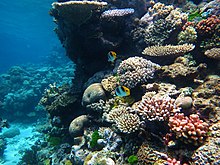User:Debm73/sandbox
Sandbox draft for S. mestus article
Anatomy[edit]
Cephalopods share many similar anatomical structures and it can be hard to distinguish between different species in certain situations. All cephalopods have a similar basic anatomical plan. Structures include a set of limbs that diverge from the head in a ring around the mouth. Major body parts such as reproductive systems, digestive organs and the gills are contained in the mantle (a muscular bag) at the posterior portion of the animal.[1]
Cuttlefish including S. Mestus differ from octopuses as they have an additional pair of limbs that octopuses lack. These limbs are known as feeding tentacles. These tentacles are found between arms three and four. The feeding tentacles are typically used for extended quickly to capture prey. [1]
S. mestus is commonly referred to as the red cuttlefish. When undisturbed it is typically recognized by its red colouration and two dark spots on the posterior of the animal.[2]
Mobility[edit]

S. mestus propells itself through the water using a technique that is seen in many Cephalopods. Water is pushed through a cavity that is formed by the mantle. The animal ejects water from the mantle via a tubular funnel. This technique allows the animal to move through the environment using jet propulsion. A relaxed mantle allows for water to fill the mantle cavity. A contracted mantle forces water out through the tubular funnel. The funnel can be pointed in different directions allowing for movement forward and backward away from predators or towards prey. [1]
Common Predators and Prey[edit]

Some common predators of S. mestus include bluefish (Pomatomus saltatrix), summer flounder (Paralichthys dentatus), and black seabass (Centropristis striata).[3]
Common prey of S. mestus and other cuttlefish include different species of shrimp, crab, and young fish.[4]
Anti Predator Behaviour[edit]
Camoflauge is a distinctive feature of Cephalopods including S. mestus. Camouflage is achieved through changing of the animals colour and texture. Small organs in the skin allow called chromatophores allow for colour change. These chromatophores can be described as very small bags of dense pigment that can be expanded or contracted in which a spot of particular colour can be displayed.[1]
S. mestus and most other species of cuttlefish can alter skin texture to blend in with their environment. This is achieved by pushing up flaps of skin to match shapes of rock, coral, and seaweed. These flaps are known as papillae. Contracting rings of muscle around the base of these papillae allows for the flaps to rise, changing the appearance of the animal. [1]
S. mestus can also bury itself under the sand to avoid predators[1]
Dispersal of Eggs[edit]
All cuttlefish including S. mestus disperse their eggs by attachment to the sea floor, usually on or under hard surfaces such as rock and coral. [1]
Habitat[edit]

Many of the worlds cuttlefish species are found in Australian waters, Including S. mestus.[5]
References[edit]
- ^ a b c d e f g Norman, Mark; Reid, Amanda (2000). "Guide to Squid, Cuttlefish and Octopuses of Australasia". doi:10.1071/9780643101098.
{{cite journal}}: Cite journal requires|journal=(help) - ^ Falkner, Inke, author. Underwater Sydney. ISBN 9781486311194. OCLC 1119635583.
{{cite book}}:|last=has generic name (help)CS1 maint: multiple names: authors list (link) - ^ Staudinger, Michelle D.; Buresch, Kendra C.; Mäthger, Lydia M.; Fry, Charlie; McAnulty, Sarah; Ulmer, Kimberly M.; Hanlon, Roger T. (2013-12). "Defensive Responses of Cuttlefish to Different Teleost Predators". The Biological Bulletin. 225 (3): 161–174. doi:10.1086/bblv225n3p161. ISSN 0006-3185.
{{cite journal}}: Check date values in:|date=(help) - ^ Darmaillacq, Anne-Sophie; Chichery, Raymond; Poirier, Roseline; Dickel, Ludovic (2004). "Effect of early feeding experience on subsequent prey preference by cuttlefish,Sepia officinalis". Developmental Psychobiology. 45 (4): 239–244. doi:10.1002/dev.20034. ISSN 0012-1630.
- ^ REID, AMANDA L.; LU, CHUNG-CHENG (2005-03-21). "A new cuttlefish, Sepia filibrachia n. sp., from the South China Sea with a redescription of Sepia mestus Gray, 1849 (Cephalopoda: Sepiidae) from eastern Australia". Zootaxa. 911 (1): 1. doi:10.11646/zootaxa.911.1.1. ISSN 1175-5334.
 | This is a user sandbox of Debm73. You can use it for testing or practicing edits. This is not the sandbox where you should draft your assigned article for a dashboard.wikiedu.org course. To find the right sandbox for your assignment, visit your Dashboard course page and follow the Sandbox Draft link for your assigned article in the My Articles section. |
